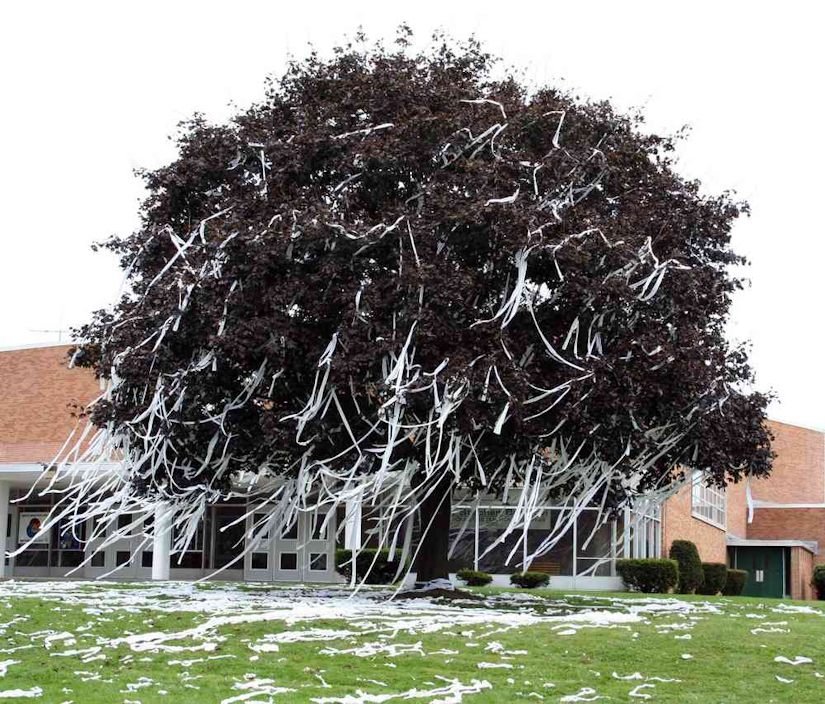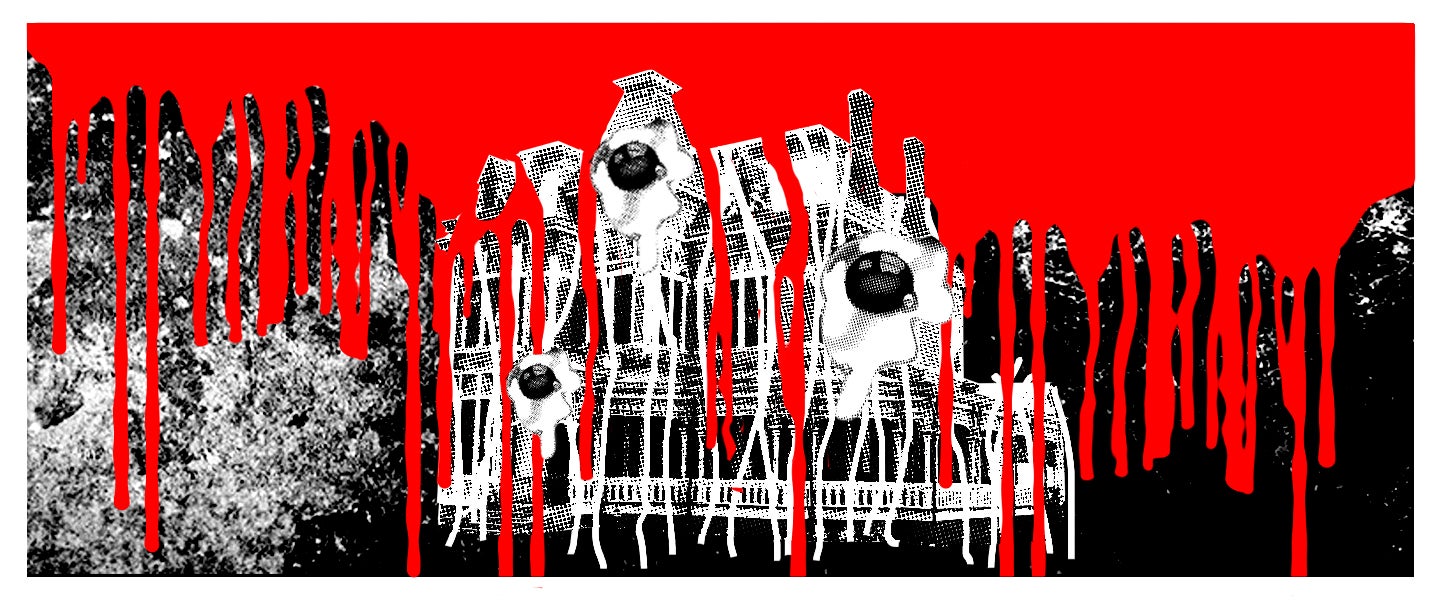Around the Great Lakes area, they call it “Devil’s Night.” In Massachusetts, it’s called “Cabbage Night.” There’s also “Gate Night,” “Moving Night,” “Goosey Night” and various other names, but the most widespread moniker seems to be “Mischief Night,” when children play neighborhood pranks — and sometimes worse — on the night before Halloween. While these pranks vary from the fairly harmless moving of people’s lawn furniture to deadly arson, the most common acts of mischief that occur on this night tend to be the egging and/or toilet-papering of houses.
Egging, toilet-papering, trick-or-treating and Mischief Night all have separate origins in their own right, and over the years, these disparate traditions have all converged together to cause mayhem every October 30th.
Let’s start with egging. The act of throwing raw eggs at people and places has been around a long time — at least since the Middle Ages — when prisoners placed in stocks were known to be pelted with eggs to further their humiliation. The practice then extended to the theater, when Elizabethan theater-goers would show their disapproval for a poor performance with rotten vegetables and eggs thrown at the actors. Politicians got it too, and occasionally, this still happens, as Arnold Schwarzenegger was pegged with an egg while running for governor of California in 2003. More recently, the Australian “Egg Boy” went viral for egging a Muslim-hating politician, who then retaliated by punching the boy.
Eggs have proven to be popular ammunition for fairly obvious reasons: They’re small, making them easy to carry and conceal, and they’re also cheap and plentiful, making any necessary re-armaments easy to attain. They also require no ID to buy and aren’t all that suspicious of a purchase either, even for a teen. Some naive store clerk may just think that kid is heading home to make an omelet for his mom — but no, humble store clerk, that teen has nefarious deeds in mind!
As for toilet-papering — or “TPing” — that practice is a bit newer than egging, as toilet paper has only been around since the 1850s. And while it likely started as a fairly harmless form of vandalism earlier than the 1960s, it was during this decade that it seems to have become more popular, as that’s when “toilet-paper” began to be used as a verb. Much like egging, the ammunition is cheap and easily attained by anyone and — while egging can strip paint and cause actual damage — toilet papering seems more innocent, yet still wholly effective, as the bright white ribbons are very noticeable. In fact, a toilet-papered tree, one could argue, almost borders on artwork.

As far as Mischief Night goes, that tradition has floated around a bit on the calendar, finally settling on October 30th sometime around the early 20th century. Originally, Mischief Night referred to April 30th in the U.K., which was the eve of May Day, a holiday celebrating laborers. Much like later Mischief Nights, kids pulled pranks on April 30th, like switching street signs and locking people in their homes. While the May Day association dates back to at least 1790, the Mischief Night tradition later migrated to November 4th, the eve of Bonfire Night or Guy Fawkes Night, which celebrates the capturing of would-be regicidal bomber Guy Fawkes, and is a holiday celebrated similarly to Fourth of July here in America, i.e., with a (metric) fuck-ton of fireworks.
As for when it moved to the eve of Halloween, these references begin around the 1930s and 1940s in the U.S. While Time notes that the desperate nature of the Great Depression led to vandalism, the proximately of the dates — October 30th and November 4th — may have played a part in that change as well.
But trick-or-treating factors into this too, as the tradition of pranks on and around Halloween isn’t completely owed to Mischief Night. Halloween dates back to an old Christian holiday known as “Hallow Mass,” which honored the dead. As the CBC explains, “Back then it was called ‘souling,’ where people would collect food from neighbors’ homes in exchange for praying for their dead relatives.” That eventually grew into “mumming,” where people dressed in costumes and went door-to-door, singing for food. If a neighbor didn’t comply, however, they may have received a good-natured prank.
The tradition went away for a while, but reemerged in the early 20th century in America due to Scottish, Irish and English immigrants in the northeast. The tricks came back into fashion before the treats did, though, as Halloween became a rowdy holiday in the first few decades in the 20th century, to the point where communities actively organized to have door-to-door candy begging with children replace the vandalism. It was between the two world wars when the phrase “trick-or-treat” was likely born, as the first known occurrence was in Alberta in 1927. Halloween took a break during World War II thanks to sugar rationing, but re-emerged among Boomers in the 1950s into a largely innocent, kid-friendly affair. As for Mischief Night, by then, it had settled on the night before Halloween.
While much of the history of America’s Mischief Night is innocent, sometimes, much more serious crimes have occurred. Most notably, in the 1980s, Devil’s Night in Detroit was regularly marked by incidents of arson. The worst year was 1984, when more than 800 fires were set in the city. This would continue for years until Detroit began what was called “Angel’s Night,” where volunteers would roam the city to prevent violence. Over time — just as Halloween was wrestled away from pranksters in the 1920s — the fire-setting tradition finally stopped.
In more recent decades, even the more innocent traditions behind Mischief Night have seriously declined: Egging and TPing hardly ever occur anymore, and it seems there are a few things to blame. “I’d say it’s because everyone’s got cameras now,” explains Jim McDowell, chief of police in Goshen, New York. Curfews and increased police patrols have also contributed to their decline. While McDowell notes that he does occasionally receive Mischief Night calls nowadays, it’s nothing compared to what it was 10 or 20 years ago.
If you are one of the few unfortunate homeowners who falls victim to an egging or TPing this Halloween, though, the trick is to act swiftly, removing the toilet paper before any sort of rainfall. As for the eggs, that shit can strip your paint — particularly on cars — so you’ll want to hose them off your house before they dry, even if it means doing so in the middle of the night.
If you catch some mischievous little bastards vandalizing your home, meanwhile, you can call the cops, and they can be charged with vandalism or criminal mischief, depending on how bad the damage is. Technically — at least in New York, anyway — you can also put a kid under citizen’s arrest for this, but McDowell warns that that’s usually more trouble than it’s worth, as just holding a kid is okay, but if he runs off, you risk escalating the violence by tackling him to the ground, thus making you the one who could get in trouble. Instead, you should probably just do what McDowell says the majority of homeowners do: “Most people just let it go if it does happen. They figure it’s just kids, and they get over it.”
So if it happens to you, clean your house and trees and chalk it up to reckless youth. Or, perhaps, take a moment to admire these kids’ surprising appreciation for history.

